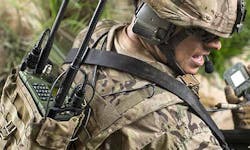Harris to provide military Special Operations radios for sensitive and covert missions
SOCOM officials have awarded an $18 million contract to Harris for Falcon III manpack and handheld tactical radios. SOCOM placed the military communications orders with Harris last fall, company officials say.
SOCOM is acquiring more Falcon III AN/PRC-117G and AN/PRC-152A radios as it expands deployment of a wideband tactical communications network, Harris officials say.
The network enables operators to send and receive tactical voice, video, and data for situational awareness and for intelligence, surveillance and reconnaissance (ISR). The AN/PRC-117G and AN/PRC-152A provide users with interoperability through legacy narrowband communications waveforms, as well as through advanced wideband data networking.
"This network is opening up a world of combat applications, such as collaborative chat, biometric enrollments, video conferencing and video ISR," says George Helm, president of U.S. Department of Defense (DOD) business at Harris RF.
The Harris AN/PRC-117G wideband multiband multimission radio is certified to the U.S. Joint Tactical Radio System (JTRS). It offers streaming video, simultaneous voice and data feeds, collaborative chat, as well as combat net radio capabilities and connectivity to secure networks.
The AN/PRC-117G's wideband networking capabilities give warfighters on the move and field commanders critical real-time information through a man-portable radio that is significantly smaller, lighter, and more capable than legacy units, Harris officials say.
Related: Harris introduces two waveforms to improve RF-7800V VHF handheld software-defined radio
With more than 10 times the processing power of currently fielded Type-1 manpack radios, the AN/PRC-117G operates in the 30 MHz to 2 GHz frequency band. The AN/PRC-117 operates off one standard battery while maintaining peak transmit power of 10 Watts VHF and 20 Watts UHF.
The radio uses the Harris Adaptive Networking Wideband Waveform (ANW2) for high bandwidth data operation and is designed for future upgrade to the Soldier Radio Waveform (SRW), and offers legacy waveforms including SINCGARS, Havequick II, VHF/UHF AM and FM, High Performance Waveform (HPW), MIL-STD-188-181B SATCOM.
The Harris AN/PRC-152A wideband networking handheld radio, meanwhile, provides simultaneous voice and high-speed data services on the move. It offers interoperability with traditional narrowband line-of-sight and satellite communications waveforms such as SINCGARS, Havequick II, and VHF/UHF AM and FM in the 30-512 MHz range.
Related: Harris RF designers expand into networked sensors applications
For homeland security operations, the radio supports APCO P25 digital trunking capability to bridge the gap between U.S. military agencies, emergency first responders, and state and local agency personnel.
On top of the traditional waveforms, the AN/PRC-152A is capable of wideband IP-based networking waveforms from 225 to 450 MHz. It offers 5 Watts of line-of-sight power and 10 Watts for satellite communications. The handheld radio offers video and image dissemination; situational awareness and mapping; text messaging and email; and mobile device applications.
For more information contact Harris RF Communications online at http://rf.harris.com.
